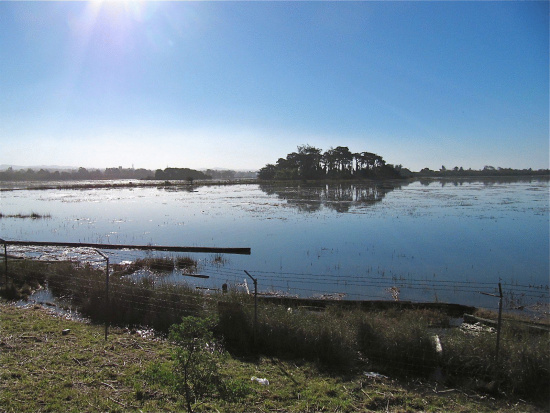
Indian Island during last year’s King Tides.
Since 1992, candlelight vigils have been held in remembrance of the Indian Island Massacre on the last Saturday in February. Candles in hand, hope in heart, the vigils serve as a path toward healing the old wounds. One of the most significant steps forward will come when the vigils are set aside because the world renewing ceremonies have again been put into place.
You see, Indian Island was once home to two ancient villages: Tuluwat, site of the renewal ceremony, and Etpidolh. The ground beneath Tuluwat, the Wiyot village, is an enormous clamshell mound (“a midden”). This mound, measuring over six acres in size and estimated to be over 1,000 years old, is an irreplaceable physical history of the Wiyot way of life. Contained within are remnants of meals, tools, and ceremonies, as well as many burial sites.
While the infamous massacre is an obvious horror, the environmental destruction is not as easily seen. We drive over the bridges, note how the high tide submerges the island, perhaps grin at the egrets. But since the end of the 19th century, dikes, channels and other modifications have changed tidal action along the shore, resulting in the edge of the mound wearing away. Between 1913 and 1985, an estimated 2,000 cubic yards of the shell mound were lost to erosion – erosion which continues today. In addition, the shell mound was the site of uncontrolled digging in the early part of the 20th century. One amateur archeologist was said to have looted as many as 500 Wiyot gravesites. Once-visible structures of the Tuluwat village are now gone, having been destroyed or carried away by wind and waves.
But all has not been lost. The hard, practical work of buying back parts of the island, removing toxins and debris, and restoring the island physically is serving to restore the Wiyot culture and, ultimately, the world renewal ceremony.
Tonight’s Ocean Night tells the story through a short film, Tuluwat: Restoring a Culture, and presentation by Wiyot tribal members and staff. The event takes place at Arcata Theatre Lounge, is all ages, and will also include the usual opening and closing surf flicks (Chris Malloy’s Groundswell follows the Wiyot presentation), plus a short look at marine debris, big picture and small. A $3 donation is asked. Ocean Night is presented by Ocean Conservancy, Humboldt Surfrider and Humboldt Baykeeper.
One primary source of marine debris has been stemmed, or at least slowed, in the City of Arcata. The city council officially passed an ordinance banning single-use plastic bags at grocery and convenience food stores, pharmacies and retail businesses beginning February 1. Exempt bags include those used for produce, meat, bulk, gift and donated bags, bags provided for prescription medications and those smaller than 625 cubic inches. Starting in August, paper bags will cost 10 cents allowing you to get used to bringing those bags along with you.
(Some people like to suggest using that single-use plastic bags that wind up choking our wildlife and uglifying our landscapes is some sort of inalienable right. I assume they live in asbestos-laden houses where the walls are still covered in lead paint and they never mind when the neighbor’s dog poops all over their yards. Anti-regulation and pro-individual liberty, amirite?)
In not-good news, commercial crabbing remains on hold locally (KMUD is promising updates) and, in definitely rotten news, climate change is the likely cause of unprecedented mass of oxygen-poor water off the Sonoma Coast, a phenomenon that could harm the region’s prized Dungeness crab and other marine life.
You know what definitely harms marine life (besides plastic bags)? High-intensity mid-frequency sonar, the kind the U.S. Navy wants to use for its warfare training exercises off the Pacific Northwest coast. The proposed exercises, with their potential for killing whales, dolphins and other sea creatures, horrified a significant number of people. Those working to stop – or at least slow down – the Navy’s plans were granted a reprieve recently, according to a Center for Biological Diversity press release”
SAN FRANCISCO – The National Marine Fisheries Service has eight months to issue a new plan to protect thousands of whales, dolphins, porpoises, seals and sea lions from ocean noise and other threats generated by U.S. Navy warfare training exercises in waters ranging from Northern California to Canada.
The ruling by Magistrate Judge Nandor Vadas of the U.S. District Court for the Northern District of California today set a deadline of August 1, 2014, for the agency to ensure that the Navy’s training activities comply with the Endangered Species Act. Today’s decision stems from a September 2013 court ruling finding the Fisheries Service at fault for green-lighting Navy training based on incomplete and outdated science.
The full press release is well worth the click. See it here.
Dead fish for a good cause. Also, naked celebs! A more cerebral, local take on overfishing – and circling back around to tribal stewardship – can be found in a new video detailing tribal participation in the North Coast implementation of the Marine Life Protection Act. Perfect timing, as the completion of the statewide marine protected area network, the only one in the county, nears its first anniversary this month.
Finally, some random great white shark news – with heart-pounding video, natch.
CLICK TO MANAGE